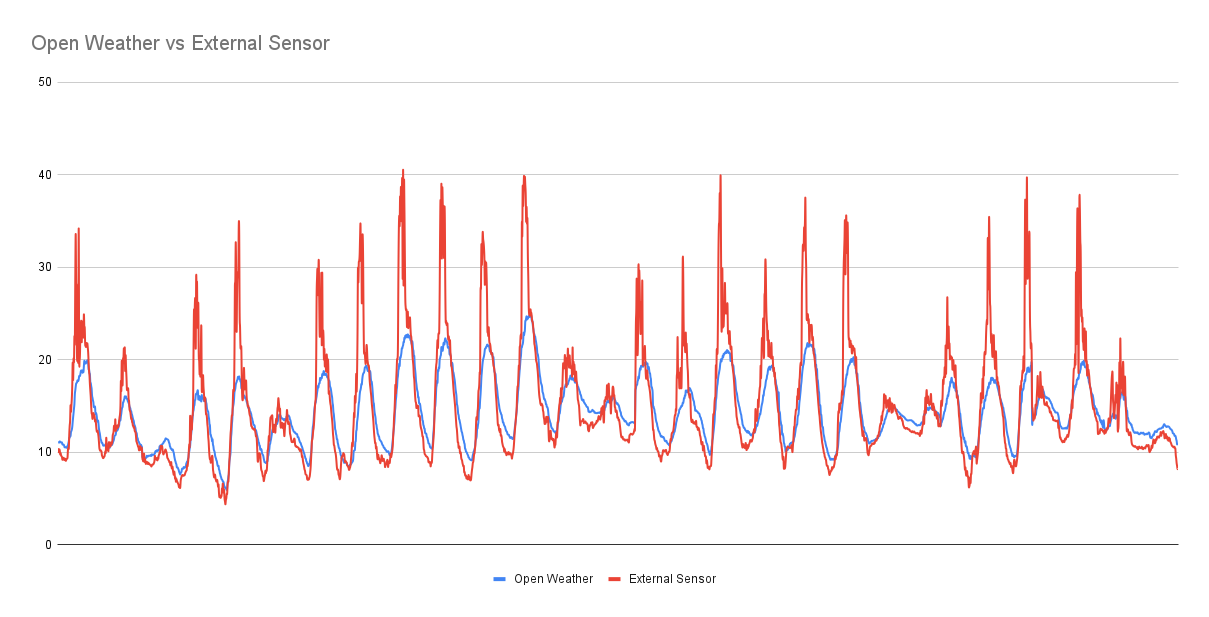Moisture Battle Part 3
For the entire month of May the sensors mentioned in part 2 have been running on the night sky pi. Throughout this month there has been varying weather conditions so I feel that a good amount of data has been collected in order to make some decisions on what to do going forward.
Results
Before the data could be looked at there was cleaning that had to take place. As there would have been times when the open weather api could not be reached due to network conditions. Once these missing elements were removed then the same results and times were also removed from the dome and external sensors. Once this was completed the results were then aligned to make the process reading for graphing.
With the graphs being completed, there was an obvious issue the sensors were running much hotter than the API. I’m putting this down to sitting in the hot sun through the day, with poor ventilation and not being actively cooled.
Open Weather API vs External Sensor
It’s very clear where from the graphs where night and day cycles are, and the extra spike in the external sensor compared to the open weather api. The sensor is working correctly, it’s most probably the housing of the sensor that is causing it to retain heat which is warming up the air around the sensor more.
However when the temperature comes down, we can see that the external sensor is coming down along with it possibly more aggressively. This is due to the location of the sensor which in the late afternoon it’s in the shade so has more opportunity to cool and throughout the night.

External vs Dome Sensors
The dome is suffering from the same issue as the external sensor with the spikes throughout the day and then coming down rather quickly in the afternoon and evening. However the spikes are more alarming due to the highs that it regularly hits. The air is getting heated in the dome, and then getting trapped and this air is also heated by the electronics within the casing. The highs of 70 degrees is no a safe temperature for the hardware and will dramatically shorten it’s life and lower it’s performance. So it obvious from these results that moisture in the evening is not my only concern, I need to remove this heat during the day. Not only to protect the hardware, but also reduce the amount of moisture in the evening as well, as warmer air contains more moisture than cold air, which is causing me the issue in the first place.

Conclusions
From the data gathered about the heat that’s getting trapped in the dome it becomes obvious that there are two issues with the camera system design. Firstly there is the issue with the moisture in the dome when the temperature comes down. However the bigger issue is the ventilation of the heat that is building up within the camera system. This is because hotter air can hold more moisture, along with the fact that warmer air cools faster. This results is far more moisture in the dome than one would expect due to it starting at a much higher temperature.
With the issue of the build up of heat being discovered, this issue is front and center, as solving the heat build up will help with the moisture issues later in the evenings. So I need to come up with a way of circulating air around the camera system, and possibly exchanging that air with the outside of the system to try and get a balance. The hope is, with the air becoming balanced with the outside, there will not be as much moisture in the dome when the evening comes around, therefore reducing the issues with moisture build up.
Remaining Moisture
I feel that there will not be that much moisture after the air has been circulated, however there will be some. Therefore there will still be a need to keep the air in the dome above the dew point. This will be done with a ring of resistors that can be turned on and off when the dew point is a few degrees away from the current temperature. This should then keep the air in the dome about the temperature of the dew point resulting in no moisture collecting on the inside of the dome. This will work in conjunction with the new air circulation system to attempt to move the air around so the moisture is eventually removed from within the dome.
As with the previous post progress can be followed with the moisture battle tag.